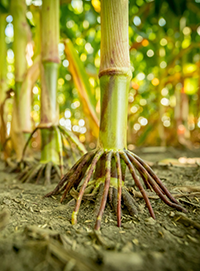
3 Key Takeaways from Article:
- Nitrogen is lost through leaching, denitrification and volatilization.
- Up to 70% of nitrogen loss happens below ground through leaching and denitrification. The remaining nitrogen loss happens above ground via volatilization, which may be minimized with good management practices.
- N-Serve® and Instinct® nitrogen stabilizers protect from N loss below ground.
The minute you apply nitrogen to your customers’ fields it’s vulnerable to loss. Nitrogen can be lost three ways: leaching, denitrification and volatilization. Incorporating nitrogen into the soil can minimize losses due to volatilization, but that will not inhibit leaching and denitrification losses. Leaching and denitrification cause up to 70% of nitrogen loss.
N loss is a serious problem. When a corn plant cannot absorb enough nitrogen through the soil, the plant will become nutrient-deficient and will cannibalize its own internal nitrogen sources. That can lead to weakened stalks, stalk rot and yield losses.
Let’s take a look at each type of loss and how you and your customers can try to protect against it.
Leaching
Leaching occurs below ground when rain washes nitrogen deep into the soil, out of the root zone and, ultimately, into waterways. N-Serve® and Instinct® nitrogen stabilizers decrease leaching by 16%,1 helping to protect your customers’ inputs and nearby watersheds.
Denitrification
Through denitrification, Nitrosomonas bacteria below ground convert stable ammonium nitrogen into unstable nitrate, which can easily escape into the air.
N-Serve and Instinct slow that conversion by suppressing the population of Nitrosomonas bacteria. The stabilizers have a bacteriostatic effect on Nitrosomonas bacteria, meaning they inhibit the activity of the bacteria, rather than killing it.
N-Serve and Instinct reduce denitrification, lessening greenhouse gas emissions by 51% and promoting 28% greater soil nitrogen retention.1
Volatilization
Volatilization is an above ground process that converts usable ammonium nitrogen into ammonia gas, which escapes into the environment instead of getting into the root zone. Volatilization is a concern for manure and urea fertilizers that are surface-applied and not incorporated into the soil.2
You can help customers avoid some of those losses by surface-applying urea or manure during cooler, calmer weather conditions at a time when the fertilizer may be incorporated by tillage or rain (around 0.5 inches or more post-application).
Protect Customers’ N
Remember, up to 70% of nitrogen loss happens below ground. A simple way to protect your growers’ input is to use a nitrogen stabilizer like N-Serve or Instinct. Both solutions deliver maximum profit by extending nitrogen availability up to 8 weeks during the key growth stages of corn. Learn more about how they work at NitrogenMaximizers.com.
1Wolt, J. D. 2004. A meta-evaluation of nitrapyrin agronomic and environmental effectiveness with emphasis on corn production in the Midwestern USA. Nutr. Cycl. Agroecosyst. 69: 23–41.
2Johnson et al. 2005. Nitrogen Basics – The Nitrogen Cycle. Agronomy Fact Sheet Series. Cornell University Cooperative Extension. http://cceonondaga.org/resources/nitrogen-basics-the-nitrogen-cycle.
™ ® Instinct is not registered for sale or use in all states. Contact your state pesticide regulatory agency to determine if a product is registered for sale or use in your state. Do not fall-apply anhydrous ammonia south of Highway 16 in the state of Illinois. Always read and follow label directions.